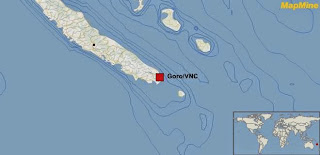 Rioters torched vehicles, equipment and buildings at Vale's nickel mine in the French Pacific territory of New Caledonia over the weekend, as anger boiled over about a chemical spill in a local river.
Rioters torched vehicles, equipment and buildings at Vale's nickel mine in the French Pacific territory of New Caledonia over the weekend, as anger boiled over about a chemical spill in a local river.
The $6 billion Vale plant at Goro in southern New Caledonia was closed earlier this month after some 100,000 liters of acid-tainted effluent leaked, killing about 1,000 fish and sparking renewed protests at the mine site.
The Vale plant has a production target of 60,000 tonnes of nickel at full capacity, compared with global supply of around 2 million tonnes. But it has been beset by problems in recent years, including several chemical spills and violent protests.
Tensions between the local population and Vale escalated over the weekend with young protesters frustrated at the latest spill by the Brazilian-based giant and a lack of response from indigenous Kanak chiefs, according to local media. Television footage showed images of burnt mining vehicles and equipment.
"There was damage at the site, but no damage to the plant. We had burned vehicles, one administration building was damaged, but no damage to the plant itself," Vale spokesman Cory McPhee told Reuters.
Peter Poppinga, an executive director at Vale, told Les Nouvelles Caledoniennes newspaper that damage to the mining site was estimated at least $20 million to $30 million, including the destruction of perhaps one third of the truck fleet.
"If there is no activity for several months, we will shut the plant, but that's not the case. The closing of the plant is not on the table," Poppinga was quoted as saying.
The scale of the damage could not immediately be independently verified.
Nickel mining is a key industry in New Caledonia, which holds as much as a quarter of the world's known reserves. Vale's plant is the second-largest employer in the southern province, with some 3,500 employees and contractors, including a large number of Filipino workers.
PLANT HALTED
New Caledonia's southern provincial government ordered an immediate halt to operations after the spill earlier this month and started legal proceedings under its environmental code.
The local government, which changed leadership last week, said it would not lift the production suspension until safety procedures were revised, an oversight committee was reinstated and an independent expert's report was completed.
"We got to this point because, clearly, part of the local youth, particularly from the southern tribes, reject the perspective of maintaining the plant in activity, even with the reinforcement of safety procedures," Philippe Michel, the newly elected president of New Caledonia's Southern Province, told local television on Monday.
Global nickel prices hit a 27-month high earlier this month and are up by about 40 percent this year, driven by a decision by Indonesia to halt exports of raw nickel ores and news of the Goro closure. Indonesia's ban left nickel buyers in China and Japan scrambling to secure supplies amid a fear of shortages.
"Vale's got lots of issues in the country," said Tom Price, a mining analyst at UBS in Sydney. "Nickel has recovered back to the marginal cost of production. It's inviting for them to continue to invest, but it's been a world of pain for them for quite a few years."
Given market expectations of Goro production of just 15,000-20,000 tonnes this year, any impact on nickel prices from the closure would be sentiment driven, Price added. LME nickel prices rose 0.7 percent to $19,745 a tonne on Tuesday.
The Goro mine produced 4,100 tonnes of nickel in the first quarter, up 41 percent on a year ago. Vale is the world's second-biggest nickel producer, but Goro made up just 6 percent of its nickel output in the first quarter.
The mine employs high pressure technology and acids to leach nickel from abundant tropical laterite ores.
"There is an inherent risk in Goro's type of operation," said Gavin Mudd, a professor of environmental engineering at Monash University in Melbourne.




